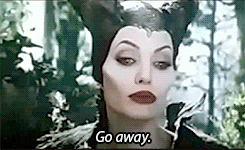Spoilers below… and all that jazz.
Unabashedly a Story about Women
At this year’s Oscars Cate Blanchett happily exclaimed that her award proves that women are not a niche market. Some of this year’s top films are evidence that people care about women and their stories. There were the Hunger Games films, which blazed the trail for future female heroines, then Frozen, which is now the fifth highest grossing film ever. In fact, movies that pass the Bechdel test are now doing better at the domestic box office than those that don’t. But the latest trend in female heroines tends to imbue them with traditionally male traits, and rarely celebrates the issues that the majority of women regularly engage with. In contrast, Maleficent is a story that is unabashedly about women, and its success demonstrates that people care about the issues that affect the “other” gender.



I felt this was fitting, what with female protagonists breaking out of their “niche” market.
The fairy tale genre has always been about women. Unfortunately, most of the time they have served as warnings for the fairer sex, telling them how they ought to behave and presenting them as either the innocent angel or the evil monster. The female protagonist is docile, gentle, and waits to be saved by her prince. Any female character who dared to possess any power was relegated to the role of villain. In new revamped fairy tales, this is beginning to shift. Audiences know people are complex, and that women are people. As a result even the most evil female characters have begun to have their own backstories. Charlize Theron’s chilling evil queen in Snow White and the Huntsman, for example.

Pretty sure she’s the main reason this movie did so well.
Maleficent is also complex, but in a way that is applicable to a contemporary (dare I say feminist?) audience. The original Sleeping Beauty story is probably the worst of all the fairy tales Disney chose to revamp, peppered with rape and murderous (cannibalistic) jealousy amongst female characters. While Disney’s first rendition simply cleaned up all the scandalous aspects of the story, Maleficent focuses on character development and, in spite of its fantastical setting, addresses two relevant issues that the majority of women deal with in some form or another.
Rape
While watching the scene when Stephan takes Maleficent’s wings, John (my SO) looked over at me, somewhat taken aback, and said, “Wow, that’s a pretty blatant metaphor for rape.” Stephan even drugs her in a moment of trust, a motion that screams “date rape”. While the rape metaphor hadn’t even occurred to me, Jolie recently affirmed suspicions regarding the scene in several interviews:
“We were very conscious, the writer [Linda Woolverton] and I, that it was a metaphor for rape. This would be the thing that would make her lose sight. At a certain point, the question of the story is what could possibly bring her back?”

In the past we’ve discussed the problem with rape as an overused trope on the blog. It is, however, quite poignant in light of the recent #yesallwomen movement. Given Jolie’s recent speech on sexual violence in war, I don’t believe the motivation of this scene was merely to move the plot forward. Instead, it addresses a modern injustice and goes beyond it to tell a tale of healing:
“The core of [the film] is abuse, and how the abused have a choice of abusing others or overcoming and remaining loving, open people. The question was asked, ‘What could make a woman become so dark? To lose all sense of her maternity, her womanhood, and her softness?'”
The reality is that many women are still abused today, but I appreciated watching a film that went beyond the act of victimization and focused on the hope of recovery.
Motherhood
After Stephan’s betrayal, we see Maleficent (quite literally) put up a wall of thorns. During years of hiding in darkness and hate, Maleficent is slowly won over by Aurora as she watches over her, waiting for her revenge curse to take hold.


Besides the charm of watching the very private Jolie interact with her real life daughter, these scenes slowly build the bond between the two women.




The film then culminates by completely rewriting the script on fairy tale endings, and concluding exactly how so many of us were hoping it would. Oh, don’t get me wrong, there is a Prince Charming, but Maleficent has to carry him to Stephan’s castle in order to get him close enough to kiss Aurora. Then, after the “good” fairies bully him into kissing Aurora… nothing happens. It is only after Maleficent kisses her on the forehead, promising to protect her as she sleeps, that the sleeping girl opens her eyes.

I loved this ending because it demonstrated how mother-daughter relationships can be beautiful. No, Maleficent didn’t give birth to Aurora, but we all know motherhood doesn’t always necessitate pregnancy and labour.
According to some estimates, there are approximately 2,254,365,000 mothers in the world. While motherhood is by no means the only valuable thing a woman will do with her life, the majority of women will dedicate a large portion of their lives to mothering. Yet how often do we see a mother-figure as a film’s protagonist? (I mean, other than really lame rip-offs; Moms Night Out, I’m looking at you.) Yes, we see obnoxious moms, nagging moms, and over-protective moms, but how often is the mother figure the hero?

I enjoyed Maleficent. For me, it was a story for the average woman. Any woman who has felt betrayed, or felt the urge to nurture or fiercely protect. But I want to know what you think. Was it really a new kind of tale, something truly for and about women? Or was it just another tired attempt to make money out of the stories we already know?























